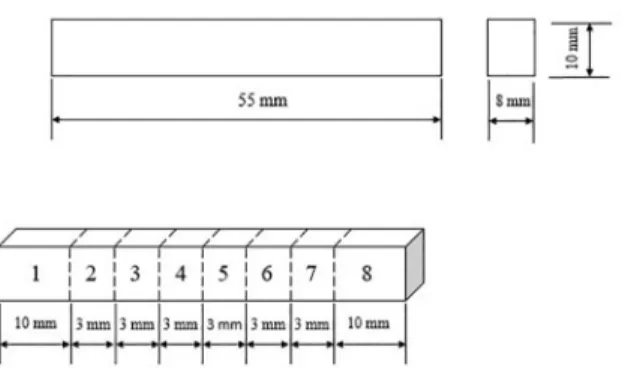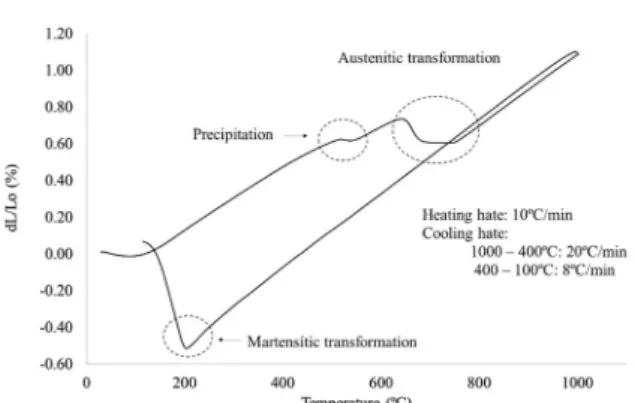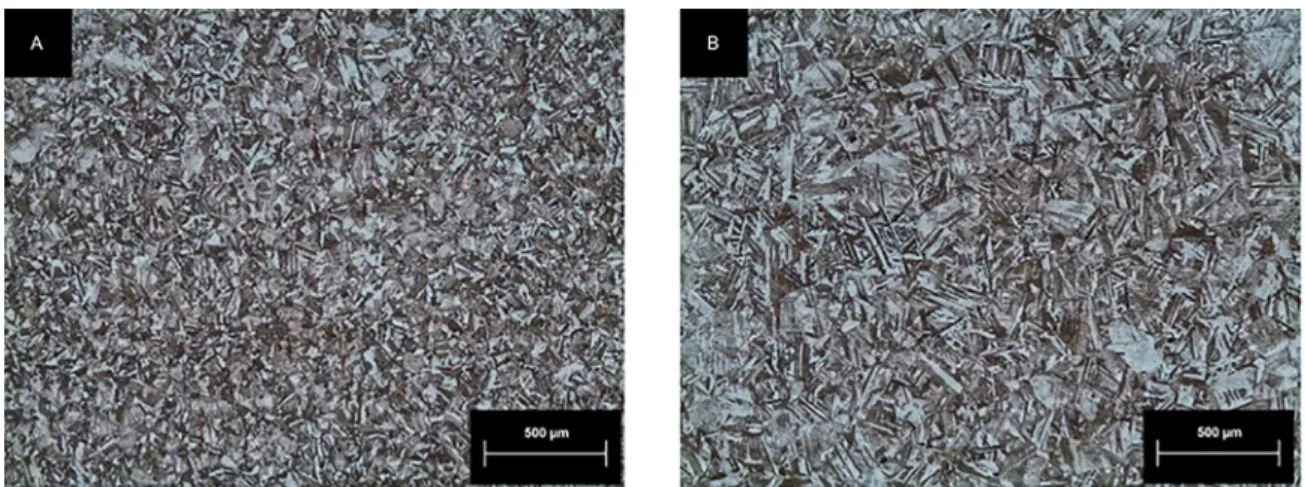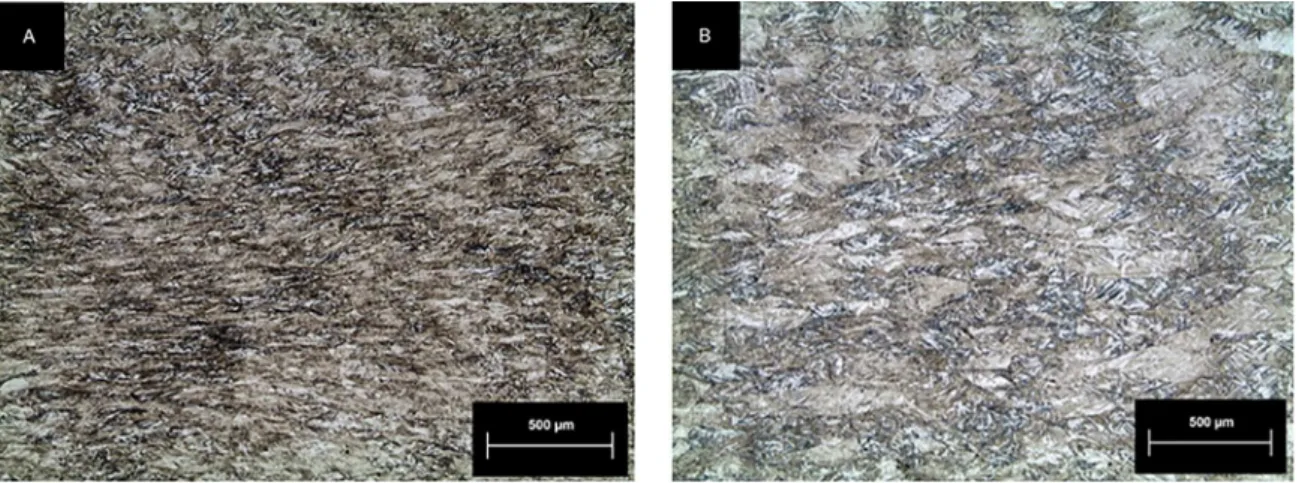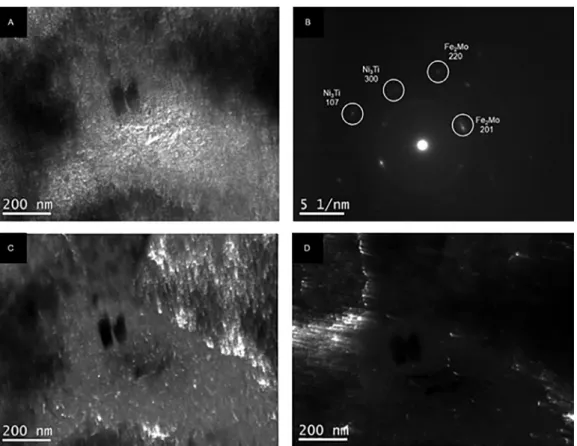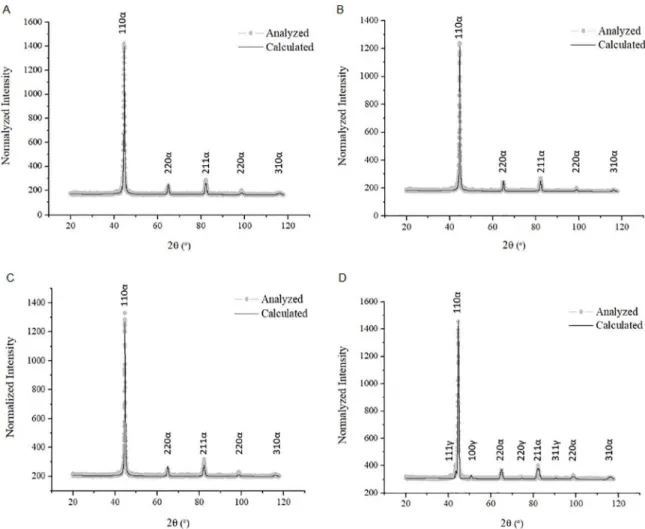Effect of Hot Deformation on Microstructure, Hardness and Precipitation Kinetics in a C350
Maraging Steel Modified by Titanium Addition
Gustavo Henrique de Oliveira Freitasa* , Carlos Augusto Silva de Oliveiraa
Received: February 16, 2018; Revised: May 18, 2018; Accepted: August 17, 2018
Maraging steels are alloys with a good balance between strength and fracture toughness. These properties are obtained by quenching and aging treatments, where the precipitation of intermetallic
compounds is promoted in a martensitic matrix. In this context, this paper aims to evaluate the effect
of hot deformation on microstructure, kinetics and formation of reverted austenite in a C350 maraging
steel modified by titanium addition, in order to improve the mechanical properties without addition of
alloying elements. The following characterization techniques were used: optical microscopy (OM),
Scanning Electron Microscopy (SEM) and Transmission Electron Microscopy (TEM), X-Ray Diffraction
(XRD), Vickers microhardness and Dilatometry. The results showed that the deformation promoted a
refinement of martensitic packages and blocks, proportional to the reduction of height and a preferred
alignment towards the center of the sample. In the aging treatment, the deformation accelerated the
kinetics of precipitation and formation of reverted austenite. It was also verified a reduction of the
volumetric variation produced by reactions and a reduction of precipitation temperature and formation of reverted austenite in the greater deformation.
Keywords: Maraging, hot deformation, precipitation, reverted austenite, precipitation kinetics.
*e-mail: gustavofreitas.engmet@gmail.com
1. Introduction
Maraging steels present high strength and good fracture toughness, allowing its use in a wide range of applications. Other important characteristics to be considered are: good conformability, good machinability and resistance to corrosion1. Despite their excellent properties, their applications are justified when the cost of the alloys is less
important than their mechanical properties. The mechanical properties of these materials are obtained by the precipitation of intermetallic compounds in the matrix during the aging treatment. However, for long aging times, the formation of reverted austenite occurs, resulting in a reduction of hardness, characterizing the overaging process1-4.
The plastic deformation of austenite before the martensitic transformation in maraging steels promotes a change in the microstructural units of the martensite, a fact that is related to the dynamic or static recrystallization of the austenite. As the deformation increases, the sizes of the packages increase while the width of the blocks decreases5. Blanter, Kovaleva and Tiskovich6 studied a maraging steel and showed that either cold or warm deformation improve the tensile strength. In a maraging C300, Güiza7 showed that the hot deformation produced a significant refinement of the
microstructure and accelerated the precipitation kinetics. He also reported that the deformation promoted changes more intensely when the martensitic transformation occurs from the non-recrystallized austenite. The following changes were
described: refinement of the martensitic microstructure and
acceleration of the formation of precipitates and formation of reverted austenite during aging. Güiza observed that the deformation promoted an increase in hardness that decreases
gradually during aging, what was justified by the recovery
mechanism. Also, studying maraging steels, Jha et al.8 showed that hot working can be used to improve the fracture toughness by redistributing the carbonitrides formed during
solidification and prevents the formation of new inclusions
during solution treatments.
Thus, deformation has been shown to be a promising process to improve the maraging steel properties by accelerating the obtained of the peak hardness during the aging and consequently reducing the time of the heat treatment. As reported by many authors5
-9, the thermomechanical process promoted good improvements on maraging steel, therefore, it should be considered, taking into account that in a large scale is more advantageous than increasing the addition of alloying element.
In this context, in order to improve the mechanical strength of these steels without increasing their manufacturing cost with the addition of alloying elements, an alternative that has been studied is the hot deformation, a process that may be able to modify the microstructure, accelerate the precipitation kinetics and improve the mechanical properties. This paper
describes the effect of hot deformation in the microstructure,
hardness and precipitation kinetics in a C350 maraging steel
modified by titanium addition.
aEngenharia Mecânica, Universidade Federal de Santa Catarina, Campus Reitor João David Ferreira
2. Materials and Methods
Prismatic test samples made from a disc of 18Ni C350 maraging steel manufactured by vacuum induction melting and vacuum arc remelting (Table 1), subsequently being
sectioned in a cut-off machine and machined to the dimensions
showed on Fig. 1. Then, they were deformed by uniaxial compression without lubrication in a 150 Ton friction drive screw press following the conditions shown in Table 2. Right after the deformation, samples were quenched in water, after that all samples were cut in small pieces, which were characterized in either the as deformed state, or after aging for 1, 5, 7,5, 10, 25 and 40 hours at 500 ºC and for 10, 30 min, 1, 5 and 10 hours at 550 ºC. For characterization, the samples were metallographically prepared following the procedures of the ASTM E3 standard, and chemically etched following the guidelines of the ASTM E407 standard, with
modified fry etchant (50 ml of HCl, 25 ml of HNO3, 1 g of CuCl2 and 150 ml of H2O) to the optical microscopy and microhardness measure, marble (4g CuSO2, 20 ml HCl, 20 ml H2O) to TEM analysis and chromic acid (10 gr CrO3, 90 ml H2O) to measure the grain size by linear intercept method. The characterization methods used are described in Table 3.
3. Results and Discussion
3.1 Dilatometry
The dilatometric curves showed a typical behavior of
the maraging steels with two inflections during heating, the first one between 480 ºC and 600 ºC corresponding
to the precipitation of intermetallics, and the second one between 640 ºC and 750 ºC corresponding to the austenitic transformation11. During cooling, a variation was observed at approximately 200 ºC equivalent to the martensitic transformation (Fig. 2).
In order to obtain the maximum reaction rate temperatures, the derivatives of dilatometrics curves were calculated (Fig. 3).
These curves showed two well defined peaks, the first one at
524 ºC related to the precipitation of intermetallics, and the second one at 664 ºC related to the formation of austenite. A third region that was observed is an irregularity between 700 ºC and 750 ºC, which decreases with the deformation.
Others authors found in this region well defined peaks and
related to the adifusional stage of austenite formation10,11. In deformed samples, two changes were observed, the
first one, a reduction of the volumetric variation produced
by reactions, and second one, in the 60% deformed samples,
a reduction of temperature of maximum rate of precipitation and austenite transformation. The reduction of contraction was also reported by others authors, on cold-deformed C350 maraging steel samples12 and in a hot-deformed C300 maraging steel13. This alteration was justified by them to the anomalies of expansion as a consequence of the texture induced by deformation.
3.2 Microstructural analysis
The non-deformed samples showed a homogeneous martensitic microstructure with the morphology of laths, blocks and packets (Fig. 4), a typical characteristic of maraging steels14.
Furthermore, the blocks and packet sizes in the samples solutionized at 1050 ºC were larger than the ones solutionized at 950 ºC. The results of linear intercept measuring of previous austenite (Fig. 5) showed that the samples solutionized at
1050 ºC previous austenite grain size significantly larger
than the ones solutionized at 950 ºC, 130 µm against 54 µm.
About the effect of deformation, it produced several
changes on the microstructure. First of all, due to the friction
between matrix and samples was observed a profile in the
microstructure as described by Dieter10, with non-deformed regions in the top and bottom, moderate deformation zones on the sides and a central concentrated shear. The deformation
promoted a refinement of the size blocks of the martensite
and a preferred alignment of the microstructure towards the center of the samples, this were observed more intensely in the greater deformation (Fig. 6).
Table 1. Chemical composition of the material.
% Wt. Ni Co Mo Ti C S Fe +
impurities
Sample 17.76 11.61 4.89 2.03 0.016 0.013 Balance
18Ni C350 18 - 19 11.5 – 12.5 4.5 – 5.2 1.3 – 1.6 Máx. 0.03 Máx. 0.010 Balance
Figure 1. Dimensions (mm) of the samples used in this study.
Table 2. Experimental conditions and number of samples used.
Temperature (ºC) Deformation (%)
0 30 60
950 2 2 2
In 30 % deformed samples a microstructure composed of
blocks with refined width in the specimens deformed both at 950 °C and 1050 °C (fig. 7) was found. In the 60% deformed
samples, were observed microstructures with larger shear bands on the sides and narrower ones in the central region (Fig. 8), this was similar to that found by Güiza in a C300 maraging steel7. It was noticed that even after the deformation,
the blocks and packets of the samples deformed at 1050 ºC kept larger than ones deformed at 950 ºC.
3.3 Precipitates
After aging for 7.5 h at 500 ºC, TEM dark field images show the reflection of the crystallographic planes (201)
and (112), characteristic of spheroidal precipitates and in
the dark field of reflection of crystallographic planes (107)
and (201) needle-like precipitates (Fig. 9). The results of measurements of the interplanar spacing of the spherical particles were similar to Fe2Mo, with lattice parameters a = 0.473 nm and c = 0.772 nm, and the needle-like to the Ni3Ti with a = 0.5101 nm and c = 0.83067 nm, both phases with hexagonal structures. These precipitates were also founded and studied by others authors at many aging temperatures15-19.
Increasing the aging time to 40 hours, were found precipitates with dense dispersion through the matrix. Qualitatively, it was possible to observe that the fraction
of these intermetallics increased significantly, what was already expected, since the kinetics is strongly influenced by
treatment time. About the morphologies, as well as in early condition, precipitates were also found in needle-like and
spheroidal, the spheroidal ones were found in the reflection of
crystallographic planes (220) and (201), and continued to be indexed as Fe2Mo (Fig. 10 - a, b and c), and, the needle-like
ones were found in the reflection of crystallographic planes
(107) and (300) as Ni3Ti. The Ni3Ti precipitates observed
in the dark field of crystallographic plane (300) were found
segregated and aligned, as shown in Fig 10 - d.
3.4 Reverted austenite
By SEM analysis rich regions of reverted austenite in non-deformed samples aged for 10 hours were found (Fig. 11),
Table 3. Characterization techniques employed.
Technique Description
Dilatometry
A Netzsch DIL 402C dilatometer was used to evaluate the effect of deformation in the temperatures of phase
transformation, precipitation and formation of reverted austenite in samples solutionized at 1050 °C. Was heating rates used was 10 °C/min.
Optical microscopy The microstructure was observed by a Olympus BX60 optical microscope with a Leica EC3 camera, the images were processed using the ImageJ software.
Scanning electron microscopy (SEM)
A Jeol JSM-6390LV microscope was employed in order to complement the analysis of the martensite morphology.
Transmission electron microscopy (TEM)
A JEM-1011 TEM microscope was used to identify crystallographically and morphologically the precipitates present in the samples solutionized at 950 ºC, non-deformed and 60% deformed, aged for 7.5
and 40 hours at 500 ºC.
X-ray Diffraction
(XRD)
A Philips X´Pert Pro diffractometer, with Cu kα radiation (λ = 1.5406 Å) was employed, with intensity measurements taken every 0.02° in the range between 30° < 2θ < 120°. Was used in the identification and quantification of the reverted austenite in non-deformed samples and 60% deformed aged for 1 and 10 hours at 550 ºC. After the measurements were made, the diffraction patterns were refined by the structural Rietveld
method using the GSAS with EXPGUI software and the angular positions and intensities of the peaks were compared with those given in the ICSD 632934 and 632930 for the martensite and austenite phases.
Hardness Testing
A Shimadzu HMV2 microhardness tester with a load of 1kgf, according to ASTM standard. In the deformed samples, the measurements were made in concentrated shear regions formed by the compression as shows in
Dieter10and in the non-deformed samples were taken randomly.
Figure 2. Dilatometric curve of non-deformed sample solutionized at 1050 ºC.
Figure 4. Blocks and packets morphology found in the non deformed samples. Solutionized at: a) 950 ºC and b) 1050 ºC.
Figure 5. Grain size of the non deformed samples. Solutionized at: a) 950 ºC and b) 1050 ºC.
Figure 6. Effect of hot deformation on microstructure of samples solutionized at 1050 ºC. Condition: a) non-deformed samples, b) 30 %
deformed and c) 60 % deformed.
that wasn’t found in the Rietveld refinement. The refinement of the diffraction pattern just showed reverted austenite in
60 % deformed samples aged at 550 °C for 10h, 8.2 %, the other conditions showed only the martensite (Fig. 12), this shows that the deformation had an important role in the formation of reverted austenite found in the steel. The angular positions and intensities of the peaks were compared with those given in the ICSD 632934 and 632930 for the martensite and austenite phases, respectively, and an excellent agreement was observed (Table 4). Regarding the morphology,
reverted austenite was observed in ribbons between blocks and packets. At this temperature, Li20 also found in a C350 maraging steel, a greater amount of reverted austenite, the less quantity found in this paper may be due to the higher
content of titanium, which affect the enrichment of nickel
in the matrix retarding the formation of reverted austenite.
3.5 Hardness
Figure 7. Effect of 30 % hot deformation in the microstructure. Solutionized at: a) 950 ºC and b) 1050 ºC.
Figure 8. Effect of 60 % hot deformation in the microstructure. Solutionized at: a) 950 ºC and b) 1050 ºC.
as greater the deformation, greater was the increase in hardness. (Fig 13). The hardness increase in the samples deformed at 950 ºC was approximately 13% and in the 1050
°C, 8%. This difference is justified by the larger grain size
of the 1050 ºC solutionized samples.
It is noted in the Fig. 13 that there wasn’t difference of
hardness between the non deformed samples solutionized at 950 and 1050 ºC, it can be related to the competition between the mechanisms of solid solution hardening and grain boundaries hardening.
As reported by others authors7,15,16,17, the behavior of maraging steel during the aging is a hardness increase until reaching a peak followed by an overaging. In this paper, the non-deformed samples solutionized at 950 ºC, aged at 500 ºC presented a hardness increase up to 5 hours, followed by a plateau up to 25 hours. In the deformed samples, the
hardness increase was verified up to 1 hour, also followed
by a plateau up to 25 hours (Fig. 14 - a), so it wasn’t found an overaging at this temperature. To see if rising the time of aging an overaging would occur, one more sample was tested and it was observed that up to 40 hours there wasn’t an overaging. In this condition, it was observed that the deformed specimens had superior hardness in the initial
periods and similar in the posterior regions, this is related to the continuous recovery of the substructure of dislocations during aging7. In the samples deformed at 1050 ºC, it wasn’t observed a significant effect between the conditions related
to deformation up to 10 hours, this can be explained by the recrystallization at this temperature. The behavior of all conditions was a hardness increase up to 7.5 hours, followed by a plateau up to 40 hours. Just in the 60% deformed samples
was observed a significant decrease of hardness from 10
hours, which indicates that the deformation accelerates the kinetic of formation of reverted austenite (Fig. 14 - b).
Increasing the aging temperature to 550 ºC, samples deformed at both temperatures, 950 ºC and 1050 ºC, had the same behavior. In non-deformed samples, there was a hardness increase up to 1 hour, followed by an overaging, and, in the deformed samples, there was a quick hardness increase until reaching the peak at 17 minutes, a plateau
up to 1 hour and finally the hardness fall characterizing the
overaging (Fig. 14 - c and d).
Figure 9. Precipitates found in non-deformed samples solutionized at 950 ºC aged at 500ºC for 7,5 hrs. a) Bright field, b) Diffraction pattern, c) Fe2Mo precipitates in the dark field of the reflection of crystallographic plane (201) and, d) Ni3Ti precipitates in the dark field of the reflection of crystallographic plane (213).
Figure 10. Precipitates found in non-deformed samples solutionized at 950 ºC aging at 500ºC for 40 hrs. Forming conditions:
Figure 11. Reverted austenite around the prior grain boundaries and between blocks and packets in non-deformed samples aged at 550 ºC for 10 hours.
Figure 12. XRD patterns obtained in the samples aged at 550 °C. Conditions: non-deformed samples (a, b). 60 % deformed samples (c, d). Aging times: a, c - 1 hr.; b, d - 10 hrs.
the peak hardness in usual C350 maraging steel within 3 hours, whereas at 550 ºC, the maximum hardness was attained in 30 minutes.
4. Conclusion
The results showed that the hot deformation promoted
a refinement of martensitic packages and blocks with a
preferred alignment directed towards the center of the sample. The deformation also increased the hardness proportionally to the reduction of height, with a maximum increase of approximately 13% in the material deformed at 950 ºC and 8% at 1050 ºC.
After aging, two types of precipitates were found, Ni3Ti and Fe2Mo, both with hexagonal structures. It was notice that the thermomechanical processing accelerated the precipitation kinetics and the formation of reverted austenite. At 500 °C the deformed specimens showed superior hardness in the early stages, what is related to the continuous recovery of the substructure of dislocations during the treatment. Increasing the temperature of aging to 550 ºC, it was observed that the deformation accelerated the obtained of the peak hardness.
By XRD diffraction, reverted austenite was just found in 60
Table 4. Convergence parameters obtained by Rietveld refinements of diffraction pattern.
Deformation 0 % 60 %
Time 1 hour >10 hours 1 hour 10 hours
a (Ǻ) CIF code a = b = c = α=2.8707 and γ=3.5491
a (Ǻ) 2.8758 2.8724 2.8742 α=2.8725 γ=3.6045
wRp 0.2754 0.3166 0.3019 0.0328
Rp 0.1770 0.2113 0.2002 0.0150
Chi**2 1.325 1.357 1.393 0.339
Figure 13. Effect of hot deformation on hardness before aging.
Figure 14. Age hardening observed in the samples aged at 500 ºC (a, b) and 550 ºC (c, d). Solutionized at: 950 ºC - a, c; 1050 ºC - b, d.
Other changes induced by deformation were: a reduction of the volumetric variation produced by reactions and a reduction of temperature of the maximum rate of precipitation and austenite transformation in 60 % deformed samples.
From the results obtained in this study it’s clear that hot deformation is a process that is capable of improving the properties of maraging steels without increasing the addition of alloying elements. Since the hardness increase
provided by the deformation before aging treatments and the acceleration of the reaction in the aging can help to reach the desirable properties.
5. Acknowledgements
The authors want to acknowledge the scholarship given by CAPES (Brazilian Research Agency) to G. H. O Freitas, and the research grant given by CNPq to C.A.S de Oliveira. Also, would like to thank to the Laboratório de Materiais Cerâmicos (CERMAT - UFSC) by SEM analysis and to the Laboratório Central de Microscopia Eletrônica (LCME) by TEM analysis. Similarly, to Laboratório de Materiais (LabMat) for performing the dilatometry tests and to the Microstructural Characterization Laboratory (LCM) for the
6. References
1. ASM International. ASM Handbook Volume 1: Properties and Selection: Irons, Steels, and High-Performance Alloys. Materials Park: ASM International; 1990.
2. Decker RF, ed. Source Book on Maraging Steels. Metals Park: American Society for Metals; 1979. 201 p.
3. Sha W, Guo Z. Maraging steels - Modelling of microstructure, properties and applications. Oxford: Woodhead Publishing; 2009.
4. Hall AM, Slunder CJ. The Metallurgy, Behavior, and Application of the 18-Percent Nickel Maraging Steels. Columbus: Battelle Memorial Institute; 1968.
5. Yao CK, Xu Z. Influence of hot-deformation on morphology and effective grain size of lath martensite in 18Ni maraging
steel. Materials Chemistry and Physics. 1986;14(6):559-568.
6. Blanter ME, Kovaleva LA, Tiskovich NL. Combined treatment of maraging steel. Metal Science and Heat Treatment. 1969;11(4):263-265. DOI: http://dx.doi.org/10.1007/BF00653189
7. Güiza GMC, Oliveira CAS. Microstructural changes produced by hot forging in a C300 Maraging Steel. Materials Science and Engineering: A. 2016;655:142-151.
8. Jha AK, Sreekumar K, Tharian T, Sinha PP. Process optimization for high fracture toughness of maraging steel rings formed by mandrel forging. Journal of Manufacturing Processes. 2010;12(1):38-44.
9. Chakravarthi KVA, Koundinya NTBN, Narayana Murty SVS, Nageswara Rao B. Microstructure, properties and hot workability of M300 grade maraging steel. Defence Technology. 2018;14(1):51-58. DOI: https://doi.org/10.1016/j.dt.2017.09.001
10. Dieter GE, Kuhn HA, Semiatin SL, eds. Handbook of Workability and Process Design. Materials Park: ASM International; 2003.
11. Viswanathan UK, Kutty TRG, Ganguly C. Dilatometric technique for evaluation of the kinetics of solid-state transformation of maraging steel. Metallurgical and Materials Transactions A. 1993;24(12):2653-2656.
12. Kapoor R, Kumar L, Batra IS. A dilatometric study of the continuous heating transformations in 18wt.% Ni maraging steel of grade 350. Materials Science and Engineering: A. 2003;352(1-2):318-324.
13. Güiza GMC. Efeito da deformação a quente sobre a microestrutura, dureza e cinética de precipitação de um aço maraging C300. (Dissertation). Florianópolis: Universidade Federal de Santa Catarina; 2015. 145 p.
14. Tamura I, Tsuzaki K, Maki T. Morphology of Lath Martensite Formed from Deformed Austenite in 18% Ni Maraging Steel. Journal de Physique Colloques. 1982;43:C4-551-C4-556.
15. Sha W, Cerezo A, Smith GDW. Phase chemistry and precipitation reactions in maraging steels: Part III. Model alloys. Metallurgical and Materials Transactions A. 1993;24(6):1241-1249.
16. Sha W, Cerezo A, Smith GDW. Phase chemistry and precipitation reactions in maraging steels: Part IV. Discussion and conclusions. Metallurgical and Materials Transactions A. 1993;24(6):1251-1256.
17. Vasudevan VK, Kim SJ, Wayman CM. Precipitation reactions and strengthening behavior in 18 Wt Pct nickel maraging steels. Metallurgical Transactions A. 1990;21(10):2655-2668.
18. Tewari R, Mazumder S, Batra IS, Dey GK, Banerjee S. Precipitation in 18 wt% Ni maraging steel of grade 350.
Acta Materialia. 2000;48(5):1187-1200.
19. Pardal JM, Tavares SSM, Terra VF, Da Silva MR, Dos Santos DR. Modeling of precipitation hardening during the aging and overaging of 18 Ni-Co-Mo-Ti maraging 300 steel.
Journal of Alloys and Compounds. 2005;393(1-2):109-113.
20. Li X, Yin Z. Reverted austenite during aging in 18Ni (350) maraging steel. Materials Letters. 1995;24(4):239-242.
